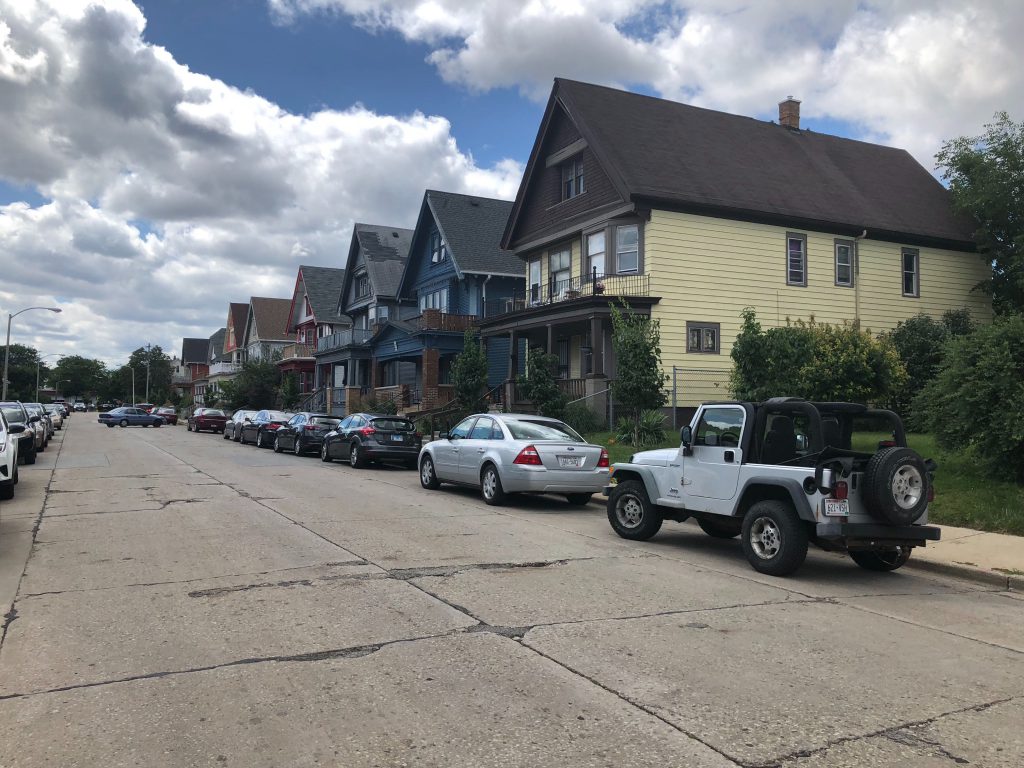Growing MKE Plan Suffers Sudden Growing Pains
Much criticism, fears of gentrification at hearing from central city residents.
City Hall played host Monday to one of the more unusual public meetings in recent Milwaukee political history.
The five-hour hearing before the City Plan Commission was about what seemed a fairly straightforward matter: the Department of City Development (DCD) is advancing its Growing MKE plan to allow more housing types to be developed across the city to accommodate changing household sizes and Mayor Cavalier Johnson‘s vision of growing the city to one million residents.
“This plan is a piece, and only a piece, of a larger strategy Mayor Johnson’s administration is implementing every day to make Milwaukee a more attractive place to live,” said City Development Commissioner Lafayette Crump, who said the vision is to grow the tax base to reverse service cuts and grow the housing supply to provide a larger amount of affordable housing, prevent displacement and slow or prevent rent increases.
“Our city used to have 150,000 more people than it has right now,” said Crump describing a multi-decade period of public service reductions. “Less residents means it’s more expensive for everyone, including existing homeowners.”
But residents, most from the Metcalfe Park and Midtown neighborhoods, had a long list of other things they wanted to talk about including drug dealing, potholes, historic segregation, racism, schools, absentee slumlords, the Housing Authority and public safety.
At the root of their concerns is a feeling that the city has ignored residents of several central city neighborhoods in developing the Growing MKE plan and several other initiatives.
Area Alderman Russell W. Stamper, II, who sent out a press release before the meeting comparing the proposal to the massive demolition that took place for the unbuilt Park West Freeway, amplified their concerns early in the hearing.
“As it stands right now, I am in total, diabolic opposition (to the) plan and all the false narratives that are presented,” said Stamper, without naming any narratives.
His colleagues took a more measured approach.
“This is what this is about. It’s about listening to our community,” said Alderwoman Sharlen P. Moore. “I am here to be a listening ear and learn as much as I can.”
Plan Commission Chair Stephanie Bloomingdale said, before taking any testimony, that no vote would occur during the hearing and that any future vote would serve only as a recommendation to the full Common Council. But that resulted in several objections from opponents, including Stamper, that lasted throughout the meeting. She made plenty of use of her gavel to attempt to maintain order during the hearing.
Commissioner Allyson Nemec said that a delay is what dozens of the letters submitted in advance of the meeting asked for.
Before any testimony was taken Crump and other DCD representatives said there would be more community engagement after the hearing. But plenty of speakers alleged that not enough of this happened to date.
“This is really kind of a simple matter if you look at it,” said Megan Shephard Smith, a Midtown resident, secretary of Midtown Neighborhood Alliance and first member of the public to speak. “The residents have not been engaged effectively.”
“The reason this room is so full is because of a lack of engagement,” said Dynasty Ceasar of the Redress Movement.
Melody McCurtis, executive director of Metcalfe Park Community Bridges, said her neighborhood received a meeting in March. But she was critical of what resulted. “They already had a plan,” she said.
After securing council approval for the effort in 2022, DCD began formally working on the plan in early 2023. It hosted a library-and-online-centric outreach plan throughout the year and released a draft in April 2024. As a result of feedback, it reduced the areas in which new, small multi-family buildings could be constructed in advance of Monday’s hearing and made a series of other tweaks.
But McCurtis wants at least a six-month delay for even more engagement. “A month ain’t going to do it,” she said. McCurtis called for outreach in line with what was done for the 2021 Fond du Lac and North Area Plan, which she said was developed with people from her neighborhood. “We are tired of hearing we are not high-level thinkers. We are geniuses.”
While there were speakers in support, most of those who spoke attacked the city and its process.
“I don’t call for a six month pause, let’s pause this for another year or two years,” said Ramona Curry. Her wide ranging criticism included labeling Milwaukee Public Schools as a “pipeline to prison” and pointing out issues with the city-affiliated Housing Authority of the City of Milwaukee.
“I wish you all would stop lying,” said Five Points area leader Fatima Laster. She said the plan would “expedite gentrification” and “100% displace Black people from Milwaukee.”
Marquette University researcher John D. Johnson, in support of the proposal, said the city’s most impoverished neighborhoods were unlikely to see direct change from the proposal. “I think that actually for good or ill, the Growing MKE plan won’t affect those areas of the city,” said Johnson, who lives in Uptown. He said the proposal would allow more housing in areas where market demand exists, which would limit the number of people that want to live in one neighborhood but end up picking another neighborhood because of a lack of supply or rising prices. “Not having enough housing in Washington Heights ends up creating displacement in other areas of the city in this pernicious way.”
As intended, the plan would allow incremental increases in density. The concept, being implemented in several cities across the country, is to allow the creation of more housing units in in-demand areas to moderate supply-and-demand driven price increases. It would also make it easier to develop “missing middle” housing types like rear cottages (accessory dwelling units) that could provide housing for seniors seeking to age in place or new residents.
But the nuances of such a proposal, including that the plan is only the start of a process to produce future zoning code changes, was largely ignored in favor of big-picture concepts.
“The legacy of anti-Blackness in this community has not been addressed and dealt with,” said Rodney Johnson.
“No one asked us ‘what do we need in our community?'” said Marion Autman.
Pastor Joseph Ellwanger, a resident of Lindsay Heights, said the plan would grow Milwaukee if it involved requirements on hiring city residents for construction work.
Other speakers talked about poverty, problems with absentee landlords, public safety issues and fears about displacement. One speaker, after detailing specific dangerous conditions in her apartment complex, was requested to provide her address so a referral could be made for intervention. “We heard a lot about where you live and we think that needs to be addressed,” said Bloomingdale.
Nicole Robinson, a research consultant with Leverage Philanthropic Partners, said the plan would harm Milwaukee and was being developed as a “veiled form of white supremacy.” She said the commission would regret endorsing it and said it should instead explore “housing reparations,” as another speaker suggested. “This plan on its own just expedites gentrification” and would result in “complete gentrification and elimination of Black neighborhoods.”
“I am interested in hearing what people are specifically opposing,” said high school senior and Youth Council member Owen Driscoll, speaking after many had left. He said he believed DCD would follow through on its commitment for more public outreach.
There was one speaker who dove into details.
“The presentation you got today is not the version we got,” said Danell Cross after Crump, DCD planning manager Sam Leichtling and planner Amy Oeth gave the commissioners an update on a plan they had been briefed on periodically over the past 18 months. “We want to know about parking. We want to know about facade.” Cross said she wanted further reductions in the proposed allowed density increases. “I am not even comfortable with the four plex.” There are no substantial parking changes recommended in the plan.
“I want them to put some safe guards around the amount of [low income housing] tax credit you can build in our neighborhood,” said Cross.
Some supporters endorsed the plan, but said more needed to be done with engagement. “I’ve listened a lot and I agree with a lot of what has been said,” said Marybeth McGinnis.
But others cautioned that seeking more engagement shouldn’t come at the expense of protracted delays, given that the city is already appearing in national lists for rent increases. “I also worry about the unintended consequences of not passing this plan,” said Aaron Moriak.
After the hearing concluded, commissioners discussed what they just experienced.
“That was a lot,” said Commissioner Tarik Moody, who said he had researched what had been done in other cities like Minneapolis.
“There are a lot of opportunities here,” said Commissioner Willie Smith, taking a positive view. “I see this as an opportunity to reach out to other partners.”
Nemec, referencing a critique that you needed a college degree to understand details of the zoning code, said a “clear as it can be” glossary should be added.
Commissioner Catrina Crane said the hearing reinforced that outreach to inner-city communities required a different strategy. Crane, who now works for Menomonee Valley Partners, said it reminded her of her work 20 years ago for the city in reaching out to homeowners about lead risks.
“Certainly we heard a resounding call for more communication, more involvement,” said Bloomingdale. She added she also heard calls for quality housing and affordable housing. She thanked her fellow commissioners for being upbeat.
What did DCD hear? Leichtling said he had two big takeaways: the need to explore more about homeownership efforts and displacement.
Despite the opposition seen Monday, several groups have endorsed the proposal. Those submitting letters to the city include 1000 Friends of Wisconsin, AARP Wisconsin, the Community Development Alliance, Community Advocates, Greater Milwaukee Association of REALTORS®, IndependenceFirst, Milwaukee County Transit System, Metropolitan Milwaukee Fair Housing Council, Milwaukee Habitat for Humanity, Near West Side Partners, the Pedestrian and Bicycle Advisory Committee, Take Root Milwaukee, United Community Center and the Urban Economic Development Association of Wisconsin. A number of the letters hit on three repeated points that should be addressed: reducing housing costs, addressing residential segregation and improving public health outcomes.
Legislation Link - Urban Milwaukee members see direct links to legislation mentioned in this article. Join today
If you think stories like this are important, become a member of Urban Milwaukee and help support real, independent journalism. Plus you get some cool added benefits.
More about the Growing MKE proposal
- Milwaukee Seeks ‘Missing Middle’ Housing Developers - Jeramey Jannene - Nov 24th, 2025
- Milwaukee Aims To Build ‘Missing Middle’ Housing in 2026 - Jeramey Jannene - Oct 29th, 2025
- Despite Its Passage, ‘Growing MKE’ Still Not A Done Deal - Jeramey Jannene - Sep 16th, 2025
- Mayor Signs Housing Legislation, Praises Late Jonathan Brostoff - Jeramey Jannene - Jul 16th, 2025
- Council Adopts Growing MKE Plan - Jeramey Jannene - Jul 15th, 2025
- After Lengthy Debate, Council Legalizes Carriage Homes - Jeramey Jannene - Jul 15th, 2025
- Housing Plan Wins Key Council Committee Endorsement - Jeramey Jannene - Jul 9th, 2025
- City Hall: Committee Waters Down Proposed ‘Granny Flat’ Plan - Jeramey Jannene - Jun 17th, 2025
- Madison Pursuing Its Own Zoning Reform Similar To ‘Growing MKE’ - Sarah Lehr - Jun 12th, 2025
- ‘Growing MKE’ Proposal Picks Up Key Endorsement - Jeramey Jannene - Jun 2nd, 2025
Read more about Growing MKE proposal here
Political Contributions Tracker
Displaying political contributions between people mentioned in this story. Learn more.
- April 22, 2019 - Cavalier Johnson received $50 from Lafayette Crump
- March 4, 2016 - Cavalier Johnson received $35 from Sharlen P. Moore
- July 20, 2015 - Russell W. Stamper, II received $50 from Lafayette Crump
City Hall
-
Council Blocked In Fight To Oversee Top City Officials
 Dec 16th, 2025 by Jeramey Jannene
Dec 16th, 2025 by Jeramey Jannene
-
Latest Effort to Adopt New Milwaukee Flag Going Nowhere
 Dec 3rd, 2025 by Jeramey Jannene
Dec 3rd, 2025 by Jeramey Jannene
-
After Deadly May Fire, Milwaukee Adds New Safety Requirements
 Dec 2nd, 2025 by Jeramey Jannene
Dec 2nd, 2025 by Jeramey Jannene





















